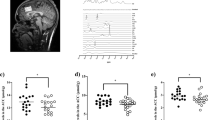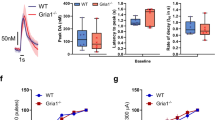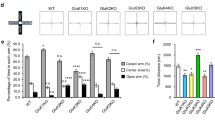Abstract
To better understand the effect of the dopamine D4 receptor (DRD4) on glutamate (Glu) neurotransmission in the brain, we utilized transgenic mice with partial or complete removal of functional DRD4 plasma membrane expression (DRD4+/− and DRD4−/−, respectively). We measured resting extracellular Glu levels, Glu clearance kinetics, and KCl-evoked release of Glu in the striatum and nucleus accumbens core of these mice using in vivo amperometry coupled to a novel microelectrode array configured for sub-second detection of Glu. Recordings from DRD4−/− and DRD4+/− mice were compared with their wild-type littermates (DRD4+/+). Resting extracellular levels of Glu were increased in the striatum of DRD4−/− mice (p<0.01). Glu clearance kinetics were significantly decreased in the dorsal striatum of DRD4−/− mice (p<0.05). KCl-evoked overflow of Glu was reliably measured but unchanged in the striatum of the three groups. By contrast, no changes in resting Glu, Glu uptake kinetics, or KCl-evoked release of Glu were observed in the nucleus accumbens core among the three genotypes. These data indicate that the DRD4 receptor is involved in modulation of Glu neurotransmission, primarily in the striatum. A better understanding of Glu control by the DRD4 may improve our understanding of the physiological role of the DRD4 in disorders such as attention-deficit/hyperactivity disorder and schizophrenia.
Similar content being viewed by others
Log in or create a free account to read this content
Gain free access to this article, as well as selected content from this journal and more on nature.com
or
References
Alexander GE, DeLong MR, Strick PL (1986). Parallel organization of functionally segregated circuits linking basal ganglia and cortex. Annu Rev Neurosci 9: 357–381.
Ariano MA, Larson ER, Noblett KL, Sibley DR, Levine MS (1997a). Coexpression of striatal dopamine receptor subtypes and excitatory amino acid subunits. Synapse 26: 400–414.
Ariano MA, Wang J, Noblett KL, Larson ER, Sibley DR (1997b). Cellular distribution of the rat D4 dopamine receptor protein in the CNS using anti-receptor antisera. Brain Res 752: 26–34.
Avale ME, Falzone TL, Gelman DM, Low MJ, Grandy DK, Rubinstein M (2004). The dopamine D4 receptor is essential for hyperactivity and impaired behavioral inhibition in a mouse model of attention deficit/hyperactivity disorder. Mol Psychiatry 9: 718–726.
Bachner-Melman R, Lerer E, Zohar AH, Kremer I, Elizur Y, Nemanov L et al (2007). Anorexia nervosa, perfectionism, and dopamine D4 receptor (DRD4). Am J Med Genet B Neuropsychiatr Genet 144B: 748–756.
Behrens PF, Franz P, Woodman B, Lindenberg KS, Landwehrmeyer GB (2002). Impaired glutamate transport and glutamate-glutamine cycling: downstream effects of the Huntington mutation. Brain 125: 1908–1922.
Benjamin J, Li L, Patterson C, Greenberg BD, Murphy DL, Hamer DH (1996). Population and familial association between the D4 dopamine receptor gene and measures of Novelty Seeking. Nat Genet 12: 81–84.
Berger MA, Defagot MC, Villar MJ, Antonelli MC (2001). D4 dopamine and metabotropic glutamate receptors in cerebral cortex and striatum in rat brain. Neurochem Res 26: 345–352.
Borland LM, Shi G, Yang H, Michael AC (2005). Voltammetric study of extracellular dopamine near microdialysis probes acutely implanted in the striatum of the anesthetized rat. J Neurosci Methods 146: 149–158.
Burmeister JJ, Gerhardt GA (2001). Self-referencing ceramic-based multisite microelectrodes for the detection and elimination of interferences from the measurement of L-glutamate and other analytes. Anal Chem 73: 1037–1042.
Burmeister JJ, Moxon K, Gerhardt GA (2000). Ceramic-based multisite microelectrodes for electrochemical recordings. Anal Chem 72: 187–192.
Burmeister JJ, Pomerleau F, Palmer M, Day BK, Huettl P, Gerhardt GA (2002). Improved ceramic-based multisite microelectrode for rapid measurements of L-glutamate in the CNS. J Neurosci Methods 119: 163–171.
Carrey N, MacMaster FP, Fogel J, Sparkes S, Waschbusch D, Sullivan S et al (2003). Metabolite changes resulting from treatment in children with ADHD: a 1H-MRS study. Clin Neuropharmacol 26: 218–221.
Carrey NJ, MacMaster FP, Gaudet L, Schmidt MH (2007). Striatal creatine and glutamate/glutamine in attention-deficit/hyperactivity disorder. J Child Adolesc Psychopharmacol 17: 11–17.
Cass WA, Gerhardt GA (1995). In vivo assessment of dopamine uptake in rat medial prefrontal cortex: comparison with dorsal striatum and nucleus accumbens. J Neurochem 65: 201–207.
Cass WA, Gerhardt GA, Gillespie K, Curella P, Mayfield RD, Zahniser NR (1993). Reduced clearance of exogenous dopamine in rat nucleus accumbens, but not in dorsal striatum, following cocaine challenge in rats withdrawn from repeated cocaine administration. J Neurochem 61: 273–283.
Cass WA, Gerhardt GA, Mayfield RD, Curella P, Zahniser NR (1992). Differences in dopamine clearance and diffusion in rat striatum and nucleus accumbens following systemic cocaine administration. J Neurochem 59: 259–266.
Cooper JR, Bloom FE, Roth RH (2003). The Biochemical Basis of Neuropharmacology. Oxford University Press: Oxford.
Day BK, Pomerleau F, Burmeister JJ, Huettl P, Gerhardt GA (2006). Microelectrode array studies of basal and potassium-evoked release of L-glutamate in the anesthetized rat brain. J Neurochem 96: 1626–1635.
de Sousa SC, Karwautz A, Wober C, Wagner G, Breen G, Zesch HE et al (2007). A dopamine D4 receptor exon 3 VNTR allele protecting against migraine without aura. Ann Neurol 61: 574–578.
Defagot MC, Falzone TL, Low MJ, Grandy DK, Rubinstein M, Antonelli MC (2000). Quantitative analysis of the dopamine D4 receptor in the mouse brain. J Neurosci Res 59: 202–208.
Durston S, Tottenham NT, Thomas KM, Davidson MC, Eigsti IM, Yang Y et al (2003). Differential patterns of striatal activation in young children with and without ADHD. Biol Psychiatry 53: 871–878.
Ebstein RP, Novick O, Umansky R, Priel B, Osher Y, Blaine D et al (1996). Dopamine D4 receptor (D4DR) exon III polymorphism associated with the human personality trait of Novelty Seeking. Nat Genet 12: 78–80.
Espey MG, Kustova Y, Sei Y, Basile AS (1998). Extracellular glutamate levels are chronically elevated in the brains of LP-BM5-infected mice: a mechanism of retrovirus-induced encephalopathy. J Neurochem 71: 2079–2087.
Franklin K, Paxinos G (1997). The Mouse Brain in Stereotaxic Coordinates. Academic Press: New York.
Friedemann MN, Gerhardt GA (1992). Regional effects of aging on dopaminergic function in the Fischer-344 rat. Neurobiol Aging 13: 325–332.
Gan L, Falzone TL, Zhang K, Rubinstein M, Baldessarini RJ, Tarazi FI (2004). Enhanced expression of dopamine D(1) and glutamate NMDA receptors in dopamine D(4) receptor knockout mice. J Mol Neurosci 22: 167–178.
Gerhardt G, Rose G, Stromberg I, Conboy G, Olson L, Jonsson G et al (1985). Dopaminergic neurotoxicity of 1-methyl-4-phenyl-1,2,3,6-tetrahydropyridine (MPTP) in the mouse: an in vivo electrochemical study. J Pharmacol Exp Ther 235: 259–265.
Gerhardt GA, Palmer MR (1987). Characterization of the techniques of pressure ejection and microiontophoresis using in vivo electrochemistry. J Neurosci Methods 22: 147–159.
Gerhardt GA, Rose GM, Hoffer BJ (1986). Release of monoamines from striatum of rat and mouse evoked by local application of potassium: evaluation of a new in vivo electrochemical technique. J Neurochem 46: 842–850.
Gerhardt GA, Rose GM, Hoffer BJ (1987). In vivo electrochemical demonstration of potassium-evoked monoamine release from rat cerebellum. Brain Res 413: 327–335.
Grady DL, Chi HC, Ding YC, Smith M, Wang E, Schuck S et al (2003). High prevalence of rare dopamine receptor D4 alleles in children diagnosed with attention-deficit hyperactivity disorder. Mol Psychiatry 8: 536–545.
Guo G, Tong Y (2006). Age at first sexual intercourse, genes, and social context: evidence from twins and the dopamine D4 receptor gene. Demography 43: 747–769.
Hai-Bin T, Duan-Zhi Y, Lan Z, Li-Hua W, Chun-Fu Z, Ming-Wei W et al (2005). Dopamine D(4) receptor antagonist 3-(4-[(18)F]fluorobenzyl)-8-methoxy-1,2,3,4-tetrahydrochromeno[3,4-c]pyrid in-5-one([(18)F]FMTP): radiosynthesis and in vivo characterization in rats. Appl Radiat Isot 63: 333–342.
Hascup KN, Rutherford EC, Quintero JE, Day BK, Nickell JR, Pomerleau F et al (2006). Second-by-second measures of l-glutamate and other neurotransmitters using microelectrode arrays. In: Michael AC, Borland LM (eds). Electrochemical Methods for Neuroscience. CRC Press: Boca Raton, FL. pp 407–450.
Hebert MA, Gerhardt GA (1999). Age-related changes in the capacity, rate, and modulation of dopamine uptake within the striatum and nucleus accumbens of Fischer 344 rats: an in vivo electrochemical study. J Pharmacol Exp Ther 288: 879–887.
Jaber M, Robinson SW, Missale C, Caron MG (1996). Dopamine receptors and brain function. Neuropharmacology 35: 1503–1519.
Kennedy RT, Thompson JE, Vickroy TW (2002). In vivo monitoring of amino acids by direct sampling of brain extracellular fluid at ultralow flow rates and capillary electrophoresis. J Neurosci Methods 114: 39–49.
Lichter JB, Barr CL, Kennedy JL, Van Tol HH, Kidd KK, Livak KJ (1993). A hypervariable segment in the human dopamine receptor D4 (DRD4) gene. Hum Mol Genet 2: 767–773.
Lou HC, Henriksen L, Bruhn P, Borner H, Nielsen JB (1989). Striatal dysfunction in attention deficit and hyperkinetic disorder. Arch Neurol 46: 48–52.
Luthman J, Friedemann MN, Hoffer BJ, Gerhardt GA (1993). In vivo electrochemical measurements of exogenous dopamine clearance in normal and neonatal 6-hydroxydopamine-treated rat striatum. Exp Neurol 122: 273–282.
MacMaster FP, Carrey N, Sparkes S, Kusumakar V (2003). Proton spectroscopy in medication-free pediatric attention-deficit/hyperactivity disorder. Biol Psychiatry 53: 184–187.
Maura G, Giardi A, Raiteri M (1988). Release-regulating D-2 dopamine receptors are located on striatal glutamatergic nerve terminals. J Pharmacol Exp Ther 247: 680–684.
McGeorge AJ, Faull RL (1989). The organization of the projection from the cerebral cortex to the striatum in the rat. Neuroscience 29: 503–537.
Mrzljak L, Bergson C, Pappy M, Huff R, Levenson R, Goldman-Rakic PS (1996). Localization of dopamine D4 receptors in GABAergic neurons of the primate brain. Nature 381: 245–248.
Nickell J, Pomerleau F, Allen J, Gerhardt GA (2005). Age-related changes in the dynamics of potassium-evoked L-glutamate release in the striatum of Fischer 344 rats. J Neural Transm 112: 87–96.
Nickell J, Salvatore MF, Pomerleau F, Apparsundaram S, Gerhardt GA (2007). Reduced plasma membrane surface expression of GLAST mediates decreased glutamate regulation in the aged striatum. Neurobiol Aging 28: 1737–1748.
Noain D, Avale ME, Wedemeyer C, Calvo D, Peper M, Rubinstein M (2006). Identification of brain neurons expressing the dopamine D4 receptor gene using BAC transgenic mice. Eur J Neurosci 24: 2429–2438.
Oak JN, Oldenhof J, Van Tol HH (2000). The dopamine D(4) receptor: one decade of research. Eur J Pharmacol 405: 303–327.
Rivera A, Cuellar B, Giron FJ, Grandy DK, de la Calle A, Moratalla R (2002). Dopamine D4 receptors are heterogeneously distributed in the striosomes/matrix compartments of the striatum. J Neurochem 80: 219–229.
Rubinstein M, Cepeda C, Hurst RS, Flores-Hernandez J, Ariano MA, Falzone TL et al (2001). Dopamine D4 receptor-deficient mice display cortical hyperexcitability. J Neurosci 21: 3756–3763.
Rubinstein M, Phillips TJ, Bunzow JR, Falzone TL, Dziewczapolski G, Zhang G et al (1997). Mice lacking dopamine D4 receptors are supersensitive to ethanol, cocaine, and methamphetamine. Cell 90: 991–1001.
Russell VA, Sagvolden T, Johansen EB (2005). Animal models of attention-deficit hyperactivity disorder. Behav Brain Funct 1: 9.
Rutherford EC, Pomerleau F, Huettl P, Stromberg I, Gerhardt GA (2007). Chronic second-by-second measures of L-glutamate in the central nervous system of freely moving rats. J Neurochem 102: 712–722.
Sagvolden T, Johansen EB, Aase H, Russell VA (2005). A dynamic developmental theory of attention-deficit/hyperactivity disorder (ADHD) predominantly hyperactive/impulsive and combined subtypes. Behav Brain Sci 28: 397–419.
Seeman P, Guan HC, Van Tol HH (1993). Dopamine D4 receptors elevated in schizophrenia. Nature 365: 441–445.
Seeman P, Weinshenker D, Quirion R, Srivastava LK, Bhardwaj SK, Grandy DK et al (2005). Dopamine supersensitivity correlates with D2High states, implying many paths to psychosis. Proc Natl Acad Sci USA 102: 3513–3518.
Tarazi FI, Zhang K, Baldessarini RJ (2004). Dopamine D4 receptors: beyond schizophrenia. J Recept Signal Transduct Res 24: 131–147.
Teicher MH, Anderson CM, Polcari A, Glod CA, Maas LC, Renshaw PF (2000). Functional deficits in basal ganglia of children with attention-deficit/hyperactivity disorder shown with functional magnetic resonance imaging relaxometry. Nat Med 6: 470–473.
Thomas TC, Kruzich PJ, Joyce BM, Gash CR, Suchland K, Surgener SP et al (2007). Dopamine D4 receptor knockout mice exhibit neurochemical changes consistent with decreased dopamine release. J Neurosci Methods 166: 306–314.
Zhang K, Davids E, Tarazi FI, Baldessarini RJ (2002). Effects of dopamine D4 receptor-selective antagonists on motor hyperactivity in rats with neonatal 6-hydroxydopamine lesions. Psychopharmacology (Berl) 161: 100–106.
Zhang K, Tarazi FI, Baldessarini RJ (2001). Role of dopamine D(4) receptors in motor hyperactivity induced by neonatal 6-hydroxydopamine lesions in rats. Neuropsychopharmacology 25: 624–632.
Acknowledgements
These studies were supported by USPHS Grants DA07262, DA12062, DA017186, MH066393, and MH067497.
Author information
Authors and Affiliations
Corresponding author
Additional information
DISCLOSURE/CONFLICT OF INTEREST
The authors disclose that Greg A Gerhardt is the Director of Operations for Quanteon Limited Liability Company (Nicholasville, KY). Quanteon developed the MEAs and FAST system utilized for these studies. No financial support or compensation was provided on behalf of Quanteon. The authors, therefore, agree that none have financial support, compensation, and personal financial holdings that could be perceived as constituting a potential conflict of interest.
Rights and permissions
About this article
Cite this article
Thomas, T., Grandy, D., Gerhardt, G. et al. Decreased Dopamine D4 Receptor Expression Increases Extracellular Glutamate and Alters Its Regulation in Mouse Striatum. Neuropsychopharmacol 34, 436–445 (2009). https://doi.org/10.1038/npp.2008.74
Received:
Revised:
Accepted:
Published:
Issue date:
DOI: https://doi.org/10.1038/npp.2008.74
Keywords
This article is cited by
-
Effects of isoflurane and urethane anesthetics on glutamate neurotransmission in rat brain using in vivo amperometry
BMC Neuroscience (2023)
-
Bidirectional regulation of emotional memory by 5-HT1B receptors involves hippocampal p11
Molecular Psychiatry (2013)
-
Dopamine D4 receptor, but not the ADHD-associated D4.7 variant, forms functional heteromers with the dopamine D2S receptor in the brain
Molecular Psychiatry (2012)



